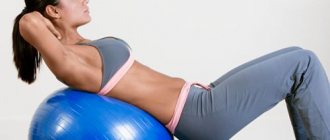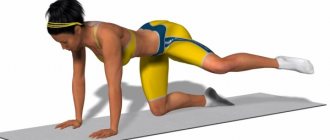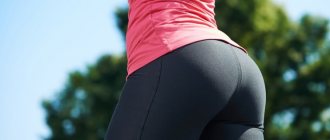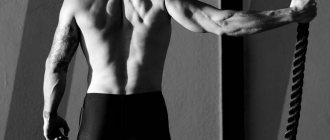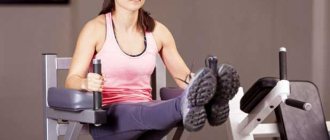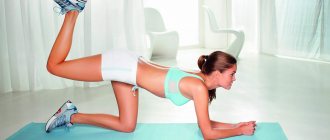Causes and mechanism of manifestation
Natural reasons:
- congenital structural feature of the buttocks;
- age-related changes;
- sudden weight gain and loss;
- hormonal changes.
External factors:
- sedentary lifestyle;
- complications of invasive interventions and plastic surgeries;
- injuries of the ligamentous apparatus of the gluteal region.
With age, the amount of collagen and elastin fibers in tissues decreases, sudden changes in weight lead to stretching of the skin and a decrease in its tone, lack of physical activity weakens muscles, and in case of injury, the integrity of the ligamentous system is disrupted. As a result, the mobility of soft tissues increases: skin, fascia, subcutaneous fat layer, they move downwards. Ptosis of the buttocks can be unilateral or bilateral.
How to determine ptosis
Severe ptosis is easily determined visually: the center of the buttocks is shifted downward, the gluteal fold tends to the outer side of the thigh. Minimal changes are not so noticeable, so there are tests to detect the presence of ptosis, the degree of its development and stage.
A ruler is used to determine the degree of sagging of the buttocks. In addition, the gluteal-femoral angle in the lateral projection is assessed.
When measuring with a ruler, it is placed under the gluteal fold. Overhang of the fold 0.5 cm below the subgluteal groove is the first degree, by 1-2 cm is the second degree, more than 2 cm is the third degree.
To assess the gluteal-femoral angle in a photograph or with the patient in profile, two lines are mentally drawn. The first is through the point of maximum convexity of the buttocks, the second is upward from the midline of the back of the thigh. Ideally, the internal angle at the intersection of these two lines does not exceed 45 °, an angle of up to 90 ° is the norm. An obtuse angle greater than 90° indicates the presence of ptosis, the stage of which increases as the angle increases.
Stages of development: buttock ptosis test using M- and T-lines
The assessment method was developed by Brazilian plastic surgeon Raul Gonzalez. In a photograph of the patient from the back, or mentally on the patient’s body in a standing position, two vertical lines are drawn. The M line runs along the midline of the back of the thigh to the top of the buttock. The T-line connects the sacrum and the ischial tuberosity. The extent to which the gluteal fold extends into these lines is then assessed and the stage of ptosis is determined.
- Normally, the fold is absent or reaches the T-line without crossing it.
- The next stage is preptosis. It is divided into minimal (the fold crosses the T-line, but does not reach the M-line), moderate (the buttock fold reaches the M-line, without going beyond it) and borderline (the fold crosses the M-line).
- With true ptosis, the gluteal fold extends significantly beyond the M-line, tending to the outer side of the thigh.
Single leg deadlift
The exercise requires strength, balance and flexibility. But without it, the back of the thigh cannot be brought closer to perfection.
Ways to tighten without surgery
In the initial stage of ptosis, you can try to give the buttocks a rounded shape and lift them using non-surgical methods. Visual tightening is provided by shapewear: tight elastic shorts, bodysuits, graces. Some models add additional volume.
Fitness classes strengthen muscles and help in the fight against excess weight and cellulite. However, if ptosis is a feature of your body type, exercise will not help. Physical activity is ineffective with age-related and hormonal changes, and is contraindicated with ligament injuries.
Manual or hardware massage, myostimulation, radio wave lifting reduce body volume by removing excess fluid, smooth out the relief and improve the appearance of the skin. These procedures are useful for minor sagging of soft tissues, but will not cope with severe manifestations.
Top 5 exercises to tighten your buttocks
The best exercises for a firm and toned butt are those that involve the maximum number of muscle fibers in the target muscle group, and also focus the load specifically on the gluteal muscles. They are ideal for lifting the buttocks by increasing the volume and tone of the muscles, as well as improving the relief.
Squats
This is the best exercise to tone your buttocks and lower body. Squats can be performed in different styles, changing the focus of the load on different areas:
- Deep – for maximum use of all gluteal muscles.
- Plie – for loading the buttocks and inner thighs.
- With the legs placed forward in Smith - to maximize the exclusion of the quadriceps from work and transfer the load to the butt.
- In the hack trainer - to minimize the work of stabilizer muscles, jerks and inertia.
- Air squats with the leg abducted to the side will put more stress on the gluteus medius muscle.
All these options must be included in training macrocycles and alternated during training. This will help avoid muscle adaptation, speed up progression and lift the buttocks.
Jumping from a deep squat
A great way to tighten your buttocks at home, although the exercise will be incredibly effective when visiting the gym. Jumps should be done in series, mainly in an explosive style. This will help provide a pronounced stress effect on the gluteal “shock” muscles.
Technique:
- Stand straight, feet shoulder-width apart, arms bent at the elbows and pressed to the chest (fists just below the chin).
- Sit down as low as possible, moving your pelvis back. The back remains straight, the heels are pressed firmly to the floor.
- Jump forward with a powerful movement, pushing yourself up with emphasis on your heel.
- Land on your toes to minimize compression.
Additionally, you can move your arms back in the air if you cannot maintain balance.
Single leg bench press in the simulator
A multifunctional exercise that can be used to work any muscle area of the legs. To tighten your butt and buttocks, it is recommended to perform it with one leg. This will allow you to better focus the load on the target muscles.
Technique:
- Sit in a chair and press tightly against the back. Hold the special handrails with your hands. Place one leg in the center of the platform, closer to the top edge, and lower the other to the floor.
- Remove the clamps and lower the platform to a right angle at the knee.
- Without pausing, push the weight away from you, returning to the starting position.
When performing the exercise, it is important to ensure that the pelvis does not bend to the side and that the body is securely fixed .
Read more about the leg press in the simulator →
Exercise "pistol"
This is a more challenging alternative to the single leg bench press. It may seem difficult at first, but this exercise for a toned butt is considered irreplaceable.
Execution technique (for beginners):
- Go to any surface that can become a support (door handle, TRX hinges, etc.).
- Grasp the support with one hand and place the other hand on your chest. The back is straight, feet shoulder-width apart.
- Begin to bend one leg at the knee, bringing the other leg forward in parallel. The lower you squat, the more you need to extend your leg (up to the level of parallel with the floor).
- Rise up slowly and without jerking, returning both legs to the starting position.
In the pistol exercise, it is important to do repetitions alternately on each leg. As you master the technique, you can secure yourself with your hand while lifting (it is important not to pull yourself up, but to avoid losing balance and “falling over” to the side). This exercise is for developing the entire lower body and is considered one of the most difficult, but at the same time the most effective. Once you master it, you will significantly speed up your progress.
Lunges
The lunge exercise has the most variations and will benefit your glutes and entire lower body. Try to alternate techniques from workout to workout or combine different execution options in a series. It is also recommended to alternate the number of repetitions, from the classic “4 x 10” to multi-repetition sets in the 5*15-20 mode.
Particular attention should be paid to the technique of Bulgarian squats. It is significantly different from classic lunges and will provide a powerful load on the buttocks and thighs even without the use of weights.
Technique:
- Step back one and a half steps from a bench or stool, feet shoulder-width apart, back straight.
- Hands are fixed on the chest or you can hold dumbbells with straight arms.
- Take one leg back and place the instep on the surface of the bench - this is the starting position.
- Slowly lower yourself down, bending your front leg at the knee. The back leg lies motionless on the bench.
- The lower you go, the better, but it is important to keep your balance and straight back.
Surgical correction
Surgical interventions are effective for the second and third degrees of true ptosis of the buttocks. Lifting or plastic surgery restores lost volume to the buttocks, gives them a beautiful shape, and tightens the skin. The correction method is selected by the doctor individually. The most commonly used are thread lifting, surgical lifting and gluteoplasty.
Thread correction (filament lifting, or Brazilian lift) is used for mildly severe ptosis. Under local anesthesia, threads are inserted under the skin of the buttocks using cannulas, which are fixed in the soft tissues using notches. The threads tighten the skin and subcutaneous fat and hold them in the desired position. The advantages of the procedure are quick recovery and no scars. The effect of thread lifting lasts from 3 to 5 years.
Surgical lifting provides a longer lasting effect. The operating doctor chooses the lifting method based on the structural features of the buttocks and the degree of tissue displacement. There is no universal surgical approach; the lift is performed through a median, lower, lateral or upper incision. During the operation, excess soft tissue is excised, muscles and skin are tightened and fixed. Surgical lifting can be done at the same time as liposuction and thigh lift.
Gluteoplasty – augmentation and correction of the shape of the buttocks with silicone implants. Implants come in round, oval and teardrop (anatomical) shapes. Round or oval endoprostheses are chosen when it is necessary to increase volume; anatomical implants are suitable for correcting asymmetry, deformation and other aesthetic defects. Gluteoplasty, as well as surgical lifting, can be combined with liposuction and hip shape correction.
Step #1: Determine your butt type
The shape of the buttocks is what is given to us by nature. It cannot be corrected, but it can be corrected with the help of special exercises for each type. In total, it is customary to distinguish four forms:
Once you have decided on the form, you can begin choosing exercises. It is important to remember that each type of buttocks requires an individual approach and the development of a specific category of gluteal muscles. For clarity, we will use the following diagram:
Now let's get down to the main thing: finding the answer to how to pump up the buttocks for each body type.


